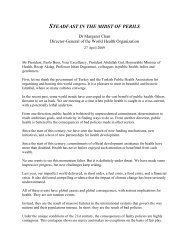The Evolution of HTA in Emerging Markets Health-Care ... - TREE
The Evolution of HTA in Emerging Markets Health-Care ... - TREE
The Evolution of HTA in Emerging Markets Health-Care ... - TREE
Create successful ePaper yourself
Turn your PDF publications into a flip-book with our unique Google optimized e-Paper software.
OHE Consult<strong>in</strong>g Report for PhRMA<br />
5 January 2011<br />
o<br />
<strong>The</strong> Urban Resident Basic Medical Insurance (URBMI) is a voluntary subsidized<br />
<strong>in</strong>surance scheme for urban residents not <strong>in</strong> formal employment <strong>in</strong>clud<strong>in</strong>g children<br />
and students.<br />
<strong>The</strong> M<strong>in</strong>istry <strong>of</strong> Human Resources and Social Security (MoHRSS) is responsible for the UEBMI and the<br />
URBMI. <strong>The</strong> M<strong>in</strong>istry <strong>of</strong> <strong>Health</strong> (MoH) is responsible for the NRCMS. <strong>The</strong> Prov<strong>in</strong>ces also play an<br />
important role.<br />
Major issues<br />
<br />
<br />
<br />
<br />
<br />
<br />
<strong>The</strong> need to move away from hospital-‐based services, build<strong>in</strong>g a strong primary care based<br />
health delivery system with <strong>in</strong>frastructure build<strong>in</strong>g (township health centres (THCs)/village<br />
cl<strong>in</strong>ics <strong>in</strong> rural areas; community health centres (CHCs) <strong>in</strong> urban areas) with the government<br />
pay<strong>in</strong>g the costs <strong>of</strong> THCs and CHCs and these centre becom<strong>in</strong>g “gatekeepers.” However, the<br />
costs <strong>of</strong> <strong>in</strong>vest<strong>in</strong>g <strong>in</strong> this additional <strong>in</strong>frastructure will be high, especially as such<br />
reconfigurations are unlikely to lead to hospital closures.<br />
<strong>The</strong> need to restructure hospital f<strong>in</strong>ances. Many fee-‐for-‐service charges are now far below<br />
the market price levels. Hospitals are unable to cover costs without other revenue sources<br />
<strong>in</strong>clud<strong>in</strong>g provid<strong>in</strong>g services that are not <strong>in</strong>cluded <strong>in</strong> the <strong>in</strong>surance package, so they do not<br />
have the right <strong>in</strong>centives to provide quality care.<br />
<strong>The</strong> need for new payment systems. One route currently be<strong>in</strong>g developed <strong>in</strong> some areas is<br />
improvements <strong>in</strong> payment mechanisms for hospitals with the development <strong>of</strong> “case based”<br />
payments, seek<strong>in</strong>g to move away from fee-‐for-‐service towards DRG-‐type payments. <strong>The</strong>se<br />
can be l<strong>in</strong>ked to cl<strong>in</strong>ical protocols derived from practice guidel<strong>in</strong>es provid<strong>in</strong>g a “bottom up”<br />
way <strong>of</strong> pay<strong>in</strong>g for good cl<strong>in</strong>ical practice.<br />
<strong>The</strong> need to tackle chronic disease with better prevention and disease management.<br />
Reduc<strong>in</strong>g the <strong>in</strong>centives for over-‐prescrib<strong>in</strong>g. Given the ability to earn much-‐needed revenue<br />
from the marg<strong>in</strong>s allowed <strong>in</strong> pharmaceutical sales, hospitals therefore tend to provide<br />
<strong>in</strong>centives for doctors to over-‐prescribe. Drug over-‐prescription and <strong>in</strong>consistent<br />
prescription has become a serious problem. Reform is under discussion to replace the 15%<br />
marg<strong>in</strong> with a flat rate amount.<br />
<strong>The</strong> need to rationalise drug spend<strong>in</strong>g. <strong>The</strong> MoH has also <strong>in</strong>troduced an Essential Drugs List<br />
with Prov<strong>in</strong>cial procurement to reduce hospital drug expenditures.<br />
A number <strong>of</strong> these issues are “macro <strong>HTA</strong>” ones around system architecture and <strong>in</strong>centives. In<br />
relation to the use <strong>of</strong> <strong>HTA</strong>, <strong>in</strong>terest <strong>in</strong> “micro <strong>HTA</strong>” has been limited:<br />
<br />
<strong>The</strong> use <strong>of</strong> <strong>HTA</strong> is conceptually accepted <strong>in</strong> government’s documents (for example<br />
documents from the NRDC, MoHRSS and MoH) but noth<strong>in</strong>g has been outl<strong>in</strong>ed as to the<br />
specifics <strong>of</strong> <strong>HTA</strong> other than the recent Memorandum <strong>of</strong> Understand<strong>in</strong>g with NICE. This<br />
54








